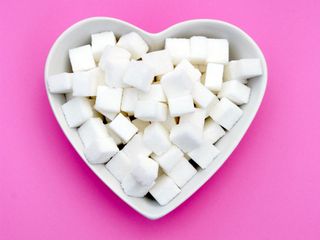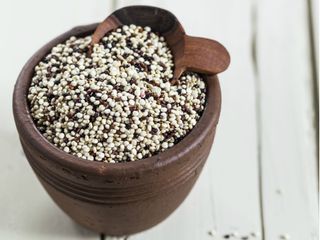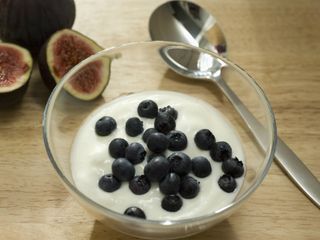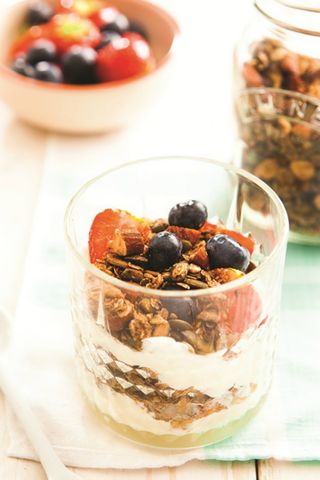Want To Try A Sugar-Free Diet? Here's 10 Ways To Beat Sugar Cravings And Break A Sugar Habit By Nutritional Therapist Elsa Jones
Nutritional therapist and author of the bestselling book 'Goodbye Sugar' Elsa Jones shares her top tips on starting a sugar-free diet, and how it can help you lose weight and keep it off

Nutritional therapist and author of the bestselling book 'Goodbye Sugar' Elsa Jones shares her top tips on starting a sugar-free diet, and how it can help you lose weight and keep it off
It's a well-known fact that eating too much sugar is bad for you, but where do you start if you want to try a sugar-free diet? We spoke to nutritional therapist Elsa Jones to get the lowdown on cutting out sugar - but don't worry, it doesn't mean saying goodbye to chocolate forever (hurrah). Read on to find out just how do-able it really is...
Elsa says, 'Over the last few decades sugar had crept into all areas of our daily diet, from the sweet treats we award ourselves to diet staples such as yogurt, soup and cereal. In fact, it’s estimated that 75 per cent of all foods contain added sugar. It’s no wonder so many of us say we feel 'addicted' to sugar and cite sugar cravings as our biggest obstacle to losing weight and keeping it off.'
'But it’s not just physical cravings that keep us hooked. Many of us have become emotionally dependent on sweet foods too, we turn to chocolate and biscuits to help comfort or reward ourselves for 'making it through the day'. It's an easy habit to fall into but one that wreaks havoc on our weight and energy levels.'
'The good news is that taking back control over your eating habits doesn't have to be a course of misery and doesn't necessarily mean eradicating sugar from your diet altogether. Most people are capable of maintaining a low sugar diet by simply having more awareness and making a few key changes to their diet and mindset.'

Here are Elsa's top tips on starting a sugar-free diet: Stop feeding your sugar monster In a nutshell, the more sugary foods you consume, the more your body will crave them. The less you consume, the less you’ll crave them. Once you stop fuelling your cravings, limiting your sugar intake becomes a lot easier. So, I recommend you start by identifying and reducing the biggest sources of sugar in your diet. For most, the obvious culprits are chocolate, biscuits, sweets, scones, soft drinks etc. Within a week, you will notice a dramatic reduction in your cravings for sweet foods. Set yourself up for success As the saying goes, 'If you fail to plan, you plan to fail', so, take a little time to get organised and prepare your environment before making any dietary changes. Where possible, remove obvious sources of temptation - if it’s not there, you can’t eat it. Also, If you share a kitchen with others at home/work, it can be helpful to ask for their support in keeping tempting foods out of sight, particularly at the start.

Choose slow-release carbs vs fast-release carbs Carbohydrates can be classed as fast or slow releasing. Fast release carbohydrates (e.g. white bread, white pasta, corn flakes, pizza) break down into glucose very rapidly which can lead to blood sugar 'highs' and 'lows'. Essentially, eating too many throws our blood sugar levels off balance leading to energy dips and further cravings for sweet or starchy foods; it's a vicious cycle. Conversely, slow release carbohydrates (brown rice, oats, quinoa) break down into glucose at a slower rate which helps to maintain stable blood sugar and energy levels.
Marie Claire Newsletter
Celebrity news, beauty, fashion advice, and fascinating features, delivered straight to your inbox!
Include a portion of protein with every meal As well as being filling, protein helps to stabilise blood sugar levels which keeps sweet cravings at bay. Protein also provides the building blocks for brain chemicals which influence appetite and satiety. At meal times, aim to fill one quarter of your plate with protein rich foods such as eggs, fish, poultry, nuts/seeds, beans or lentils. Focus on the benefits One essential technique that’ll help you stay motivated is to continuously remind yourself of what you will gain by reducing your sugar intake and following a healthier diet. If you focus on the benefits, you’ll be less likely to get swept away by cravings or feel deprived. Write the benefits down and put them somewhere you can read them everyday e.g. I'll feel good in a summer dress at my cousins wedding, I'll have more energy to exercise/play with kids, I'll be at less risk of developing type 2 diabetes like my mother.
Start as you mean to go on What you choose to eat for breakfast can set the stage for controlling blood sugar for the rest of the day so make sure to eat a balanced breakfast. Porridge oats topped with berries & a sprinkle of nuts/seeds, or eggs with rye toast will keep blood sugars stable whereas concentrated fruit juices, highly processed cereals or those high in dried fruit will have the opposite effect. Know your emotional triggers If you're like most people who struggle with a sugar habit, much of your eating behaviour is probably driven by emotions. In other words, you don’t choose to eat sugary foods just because you are physically hungry. You choose to eat sugary foods because you want to change or enhance the way you feel; this is known as 'emotional eating'. Take a moment to think about what feelings make you reach for comfort food. Is it stress, tiredness, boredom… perhaps there are certain times, people or places that trigger these feelings? Once you know, you'll be in a stronger position to overcome them.

Keep healthy snacks close to hand You’re much more likely to over-eat and/or choose the wrong type of foods when you are overly hungry and have low blood sugar. Eating little and often counteracts this, so always make sure to have healthy snacks close to hand so you have no excuse when temptation strikes. Healthy snack options that will help to curb sugar cravings and stave off an afternoon slump include: a handful of nuts with a piece of fruit, natural yogurt with cinnamon and berries, nut butter spread on sliced apple or an oat cake topped with hummus. Challenge your excuses All too often, we make excuses for ourselves in order to justify eating foods we know we oughtn't. The thought process usually starts with, 'I know I shouldn’t eat this, but it's ok because…… 'I'm stressed, I'm tired, it's just a little piece, I'll make up for it tomorrow, I deserve it.' Do any of these sound familiar? If so, write down them down. Seeing an excuse in writing helps you to see it for exactly what it is and helps you to challenge it, e.g. Excuse: 'I've had a tough day, I need to relax with a cup of tea and some biscuits.' Helpful response: 'I do need to relax but I don’t need biscuits in order to do so. I can watch a movie, read my book, go for a walk or take a bath instead.'
Practise resisting your cravings When a sugar craving hits, try a technique called 'Pause & Reflect'. So, instead of giving into your craving straight away and automatically reaching for the chocolate, you mentally press pause and commit to not responding to your craving for 10 minutes. This allows you some time to step back and acknowledge 'this is just a craving, it will pass.' Remind yourself of all the benefits you will receive by resisting your craving. Then distract yourself by focusing your attention on something else entirely for ten minutes. Go for a walk, make a call/e-mail, paint your nails, brush your teeth - you'll be surprised how quickly the craving passes.
Here are two of Elsa's top sugar-free recipes to get you started:

1. Comforting Apple & Strawberry Crumble This mouth watering crumble is naturally sweet and very versatile as any combination of fruit can be used. It’s also super quick and easy to make and yes, you guessed it, it's sugar free!
Ingredients 800g cooking apples (peeled, cored and sliced) 200g strawberries (quartered) 3 tbsp water 1 cup rolled oats 1/2 cup chopped almonds (chop in a food processor or use a knife) 1 large tbsp coconut oil, melted Pinch salt 1 tsp cinnamon
How to make Preheat oven to 190 degrees. Place the sliced fruit into a baking dish, then add the water and toss with salt to bring out some of the natural sweetness in the fruit.
In a separate bowl, mix together the oats, nuts and cinnamon, then pour in the melted coconut oil and mix well.
Spoon the crumble mixture over the fruit to cover it entirely.
Bake the crumble for 30-35 minutes or until the fruit is tender and bubbling.
Serve this 'not so naughty' dessert with a dollop of natural Greek yogurt or fresh cream.

2. Genuinely Sugar-Free Granola It is virtually impossible to find a tasty granola that is genuinely sugar free. Most brands you’ll find on supermarket shelves contain the equivalent of 3 teaspoons of sugar per serving, which is a lot. Even a lot of seemingly 'healthy' granola recipes contain lots of sugar in the form of dried fruit, honey or sugar substitutes.
The protein, fibre and essential fats in this granola will stave off sugar cravings and supercharge your energy levels at any time of the day. It works really well paired with natural yoghurt and fresh berries for breakfast or as a comforting snack to help ward off an afternoon slump.
-Makes 12 servings Ingredients 1/4 cup coconut oil 1 cup oats 1 cup sunflower seeds 1 cup pumpkin seeds 1 cup chopped almonds (you can chop them in a food processor or use a knife) 1/2 cup ground flaxseed 2 teaspoons ground cinnamon 1 teaspoon almond extract or vanilla extract (I use both) pinch of sea salt
How to make Preheat the oven to 190°C. Line two baking trays with baking paper or grease lightly with coconut oil.
Melt the coconut oil in a small saucepan and set aside.
Place all of the remaining ingredients in a large bowl and mix together.
Make a well in the middle and add the melted coconut oil. Mix thoroughly until everything is lightly coated with the oil.
Divide the granola evenly between the two trays and spread out in a thin layer.
Bake in the oven for about 15 minutes until lightly toasted and golden. Stir half way through to avoid burning.
Allow to cool, then store in an airtight container for up to 1 month.
Serve with milk of choice or natural yoghurt. Delicious served with fresh berries, grated apple or sliced pear.
Tip: Take care not to overcook as these ingredients burn easily and will taste bitter if cooked for too long. I find that the baking tray that’s placed on the lower shelf of the oven cooks a little quicker than the one on the upper shelf, so I take it out a few minutes earlier. You might need to do the same. Both recipes taken from Goodbye Sugar by Elsa Jones

Elsa Jones is a qualified Nutritional Therapist and author of bestselling book ‘Goodbye Sugar’ available to purchase in book shops and online.
The leading destination for fashion, beauty, shopping and finger-on-the-pulse views on the latest issues. Marie Claire's travel content helps you delight in discovering new destinations around the globe, offering a unique – and sometimes unchartered – travel experience. From new hotel openings to the destinations tipped to take over our travel calendars, this iconic name has it covered.
-
 Anne Hathaway had to kiss 10 men during a 'gross' chemistry audition early in her career
Anne Hathaway had to kiss 10 men during a 'gross' chemistry audition early in her careerUgh
By Iris Goldsztajn
-
 There was a hidden code in Baby Reindeer that everyone completely missed
There was a hidden code in Baby Reindeer that everyone completely missedDid you spot it?
By Jadie Troy-Pryde
-
 I'm a Health Editor who's tried 100's of shoes - these are officially the best gym trainers you can buy
I'm a Health Editor who's tried 100's of shoes - these are officially the best gym trainers you can buyFor running, weight training, walking, and more.
By Ally Head